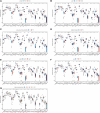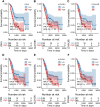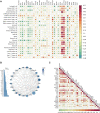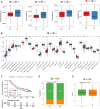Comprehensive analysis reveals signal and molecular mechanism of mitochondrial energy metabolism pathway in pancreatic cancer
- PMID: 36814901
- PMCID: PMC9939759
- DOI: 10.3389/fgene.2023.1117145
Comprehensive analysis reveals signal and molecular mechanism of mitochondrial energy metabolism pathway in pancreatic cancer
Abstract
Pancreatic cancer (PAAD) is one of the most malignant tumors with the worst prognosis. The abnormalities in the mitochondrial energy metabolism pathway are intimately correlated with the occurrence and progression of cancer. For the diagnosis and treatment of pancreatic cancer, abnormal genes in the mitochondrial energy metabolism system may offer new targets and biomarkers. In this study, we compared the dysregulated mitochondrial energy metabolism-associated pathways in PAAD based on pancreatic cancer samples in the Cancer Genome Atlas (TCGA) database and normal pancreas samples from the Genotype Tissue Expression project (GTEx) database. Then identified 32 core genes of mitochondrial energy metabolism pathway-related genes (MMRG) were based on the gene set enrichment analysis (GSEA). We found most of these genes were altered among different clinical characteristic groups, and showed significant prognostic value and association with immune infiltration, suggesting critical roles of MMRG involve tumor genesis of PAAD. Therefore, we constructed a four-gene (LDHA, ALDH3B1, ALDH3A1, and ADH6) prognostic biomarker after eliminating redundant factors, and confirming its efficiency and independence. Further analysis indicated the potential therapeutic compounds based on the mitochondrial energy metabolism-associated prognostic biomarker. All of the above analyses dissected the critical role of mitochondrial energy metabolism signaling in pancreatic cancer and gave a better understanding of the clinical intervention of PAAD.
Keywords: gene set enrichment analysis; immunotherapy; mitochondria; pancreatic cancer; prognosis model.
Copyright © 2023 Yang, Cui and Zhu.
Conflict of interest statement
Author YC is employed by Beijing GAP BioTechnology Co., Ltd. The remaining authors declare that the research was conducted in the absence of any commercial or financial relationships that could be construed as a potential conflict of interest.
Figures








Similar articles
-
Mitochondrial energy metabolism-related gene signature as a prognostic indicator for pancreatic adenocarcinoma.Front Pharmacol. 2024 Mar 20;15:1332042. doi: 10.3389/fphar.2024.1332042. eCollection 2024. Front Pharmacol. 2024. PMID: 38572434 Free PMC article.
-
System analysis based on the pyroptosis-related genes identifies GSDMC as a novel therapy target for pancreatic adenocarcinoma.J Transl Med. 2022 Oct 5;20(1):455. doi: 10.1186/s12967-022-03632-z. J Transl Med. 2022. PMID: 36199146 Free PMC article.
-
PTPN2, A Key Predictor of Prognosis for Pancreatic Adenocarcinoma, Significantly Regulates Cell Cycles, Apoptosis, and Metastasis.Front Immunol. 2022 Jan 27;13:805311. doi: 10.3389/fimmu.2022.805311. eCollection 2022. Front Immunol. 2022. PMID: 35154122 Free PMC article.
-
Comprehensive Analysis of Alteration Landscape and Its Clinical Significance of Mitochondrial Energy Metabolism Pathway-Related Genes in Lung Cancers.Oxid Med Cell Longev. 2021 Dec 20;2021:9259297. doi: 10.1155/2021/9259297. eCollection 2021. Oxid Med Cell Longev. 2021. PMID: 34970420 Free PMC article.
-
Identify potential prognostic indicators and tumor-infiltrating immune cells in pancreatic adenocarcinoma.Biosci Rep. 2022 Feb 25;42(2):BSR20212523. doi: 10.1042/BSR20212523. Biosci Rep. 2022. PMID: 35083488 Free PMC article. Review.
Cited by
-
A novel mitochondrial metabolism-related gene signature for predicting the prognosis of oesophageal squamous cell carcinoma.Aging (Albany NY). 2024 Jun 5;16(11):9649-9679. doi: 10.18632/aging.205892. Epub 2024 Jun 5. Aging (Albany NY). 2024. PMID: 38843392 Free PMC article.
-
Bioinformatics analysis of mitochondrial metabolism-related genes demonstrates their importance in renal cell carcinoma.Discov Oncol. 2025 Jan 9;16(1):28. doi: 10.1007/s12672-025-01780-4. Discov Oncol. 2025. PMID: 39789365 Free PMC article.
-
Illuminating the immunological landscape: mitochondrial gene defects in pancreatic cancer through a multiomics lens.Front Immunol. 2024 Mar 6;15:1375143. doi: 10.3389/fimmu.2024.1375143. eCollection 2024. Front Immunol. 2024. PMID: 38510247 Free PMC article. Review.
-
Establishment of a prognostic model for pancreatic cancer based on mitochondrial metabolism related genes.Discov Oncol. 2024 Aug 28;15(1):376. doi: 10.1007/s12672-024-01255-y. Discov Oncol. 2024. PMID: 39196457 Free PMC article.
-
The Mitochondrial ATP Synthase/IF1 Axis in Cancer Progression: Targets for Therapeutic Intervention.Cancers (Basel). 2023 Jul 25;15(15):3775. doi: 10.3390/cancers15153775. Cancers (Basel). 2023. PMID: 37568591 Free PMC article. Review.
References
-
- Cao Z., Lin J., Fu G., Niu L., Yang Z., Cai W. (2022). An integrated bioinformatic investigation of mitochondrial energy metabolism genes in colon adenocarcinoma followed by preliminary validation of CPT2 in tumor immune infiltration. Front. Immunol. 13, 959967. 10.3389/fimmu.2022.959967 - DOI - PMC - PubMed
LinkOut - more resources
Full Text Sources
Miscellaneous

